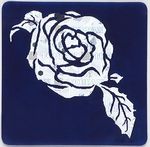A Japanese importer of alcoholic beverages and a cosmetics manufacturer are reviewing Toppan Printing Co. RFID Crystagram label, which combines 2.4 GHz passive RFID tag and a unique holographic image.
The beverage importer is looking to use the RFID Crystagram label to help prevent its products from being counterfeited or diverted into illegal channels and would also like to offer its customers a guarantee that the products are authentic. “They took an interest in our RFID Crystagram because it can solve both their requirements,” says Takuya Onuki, a Toppan Printing securities and cards specialist. The label is designed to be attractive and provide both visual authentication for customers, and the electronic trail that RFID provides. The company is still estimating the total cost required for the implementation.
The cosmetics manufacturer is studying RFID Crystagram’s potential for preventing its high-quality shampoo from being diverted or replaced with fraudulent products. The company did not want to place an RFID label on its product that might look unattractive to customers, Onuki says, “so they thought our RFID Crystagram would be a possible solution.”
Toppan Printing Co.—with the help of Hitachi and Hitachi Chemical—developed a hybrid RFID-hologram label for high-value items such as wines and electronics. The label became commercially available in February, and Toppan is in discussion with potential customers, including the beverage importer and cosmetics manufacturer, although the customers have yet to carry out pilot deployments involving the RFID Crystagram, and testing has been accomplished by Toppan in-house.
Because of sales through the Internet, the number of forged items being bought and sold worldwide is growing, says Onuki. Holograms and optical devices are often used on labels of high-value items to prevent these forgeries. With the RFID Crystagram, Toppan Printing is providing a label that combines a hologram with a tiny Hitachi RFID chip known as the µ-chip (pronounced mu-chip). The µ-chip, which transmits at 2.45 GHz and uses a proprietary air-interface protocol, is 0.4 millimeters in length and width, and 4.5 micrometers thick. Hitachi Chemical has integrated the µ-chip into a hologram. An aluminum layer on the hologram acts as the RFID antenna, giving the resulting RFID tag a read range of about 20 millimeters. Each chip carries a unique ID number and has a memory capacity of 128 bits, enough for the 38-digit ID number. That number can be linked in a back-end system to the product details such as where it was manufactured and when, as well as other descriptive details.
By integrating an RFID chip with a hologram containing a unique graphic custom-designed according to a customer’s specifications, the label provides a visual verification for those without RFID readers, Onuki says, and further traceability with the RFID capability. The hologram is important, Onuki says, since those at the retail level as well as customers are unlikely to have an RFID reader and can use the visual appearance of the hologram to verify the authenticity of a product. However with the RFID, he adds, the tag can also be used for shipping verification and inventory tracking.
The label was created with “brittle processing,” a method of adhesion that means if someone tries to remove the label from a product, the outer layer of the label would be removed but the hologram and the RFID tag would remain.

Although there are no customers yet, Toppan envisions a scenario in which manufacturers would attach the customized label to their products at the plant. The label would then be examined visually or the tag would be scanned with an RFID interrogator, at the manufacturing plant as well as at a distribution center. It could also be read by retailers to confirm that the product is authentic before it is sold to a customer.
The unique ID number encoded to the RFID tag could be used to provide an electronic record that would not only act as proof of authenticity but also could be used to track the location of a shipment and develop business analytics as to how long shipments spend at any point in that supply chain.
For authentication, the manufacturer would input the RFID tags’ unique ID numbers in a back-end Web-based server that could be accessed by other members of the supply chain, or it could forward ID numbers to those supply chain members to help them ensure the authenticity of the product.
If the RFID Crystagram was not readable or its ID number did not match data in the back-end system, the user would receive an alert.
Toppan does not offer software solutions, but Onuki says that in order to help RFID Crystagram customers deploy the technology, his company would collaborate with any system integrator or software company that has a suitable solution.
The Hitachi µ-chip is not readable by standard RFID interrogators, so those using the system would need specific µ-chip readers. “In the security world, there is often a tradeoff between wide use and high security,” Onuki says. “By using µ-chip, we compromise interoperability, but we can provide high security instead,” because the chip cannot be accessed by other readers.
The price of an RFID Crystagram label will vary depending on the volume and specific requirements of each customer, Onuki says, but the average cost is about 50 cents per unit. The company intends to continue working on cost reduction for the product, he adds.


